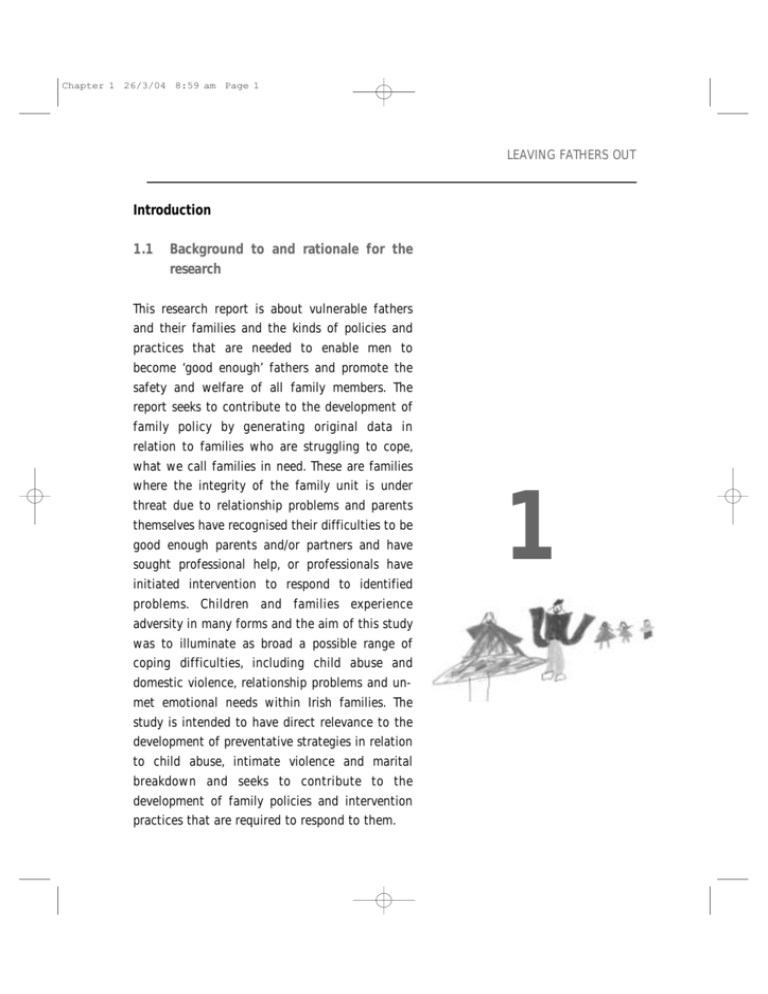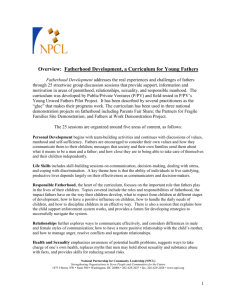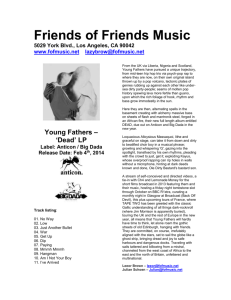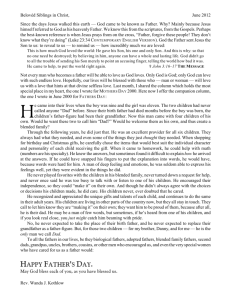Introduction 1.1 Background to and rationale for the research
advertisement

Chapter 1 26/3/04 8:59 am Page 1 LEAVING FATHERS OUT Introduction 1.1 Background to and rationale for the research This research report is about vulnerable fathers and their families and the kinds of policies and practices that are needed to enable men to become ‘good enough’ fathers and promote the safety and welfare of all family members. The report seeks to contribute to the development of family policy by generating original data in relation to families who are struggling to cope, what we call families in need. These are families where the integrity of the family unit is under threat due to relationship problems and parents themselves have recognised their difficulties to be good enough parents and/or partners and have sought professional help, or professionals have initiated intervention to respond to identified problems. Children and families experience adversity in many forms and the aim of this study was to illuminate as broad a possible range of coping difficulties, including child abuse and domestic violence, relationship problems and unmet emotional needs within Irish families. The study is intended to have direct relevance to the development of preventative strategies in relation to child abuse, intimate violence and marital breakdown and seeks to contribute to the development of family policies and intervention practices that are required to respond to them. 1 Chapter 1 26/3/04 8:59 am Page 2 Leaving Fathers Out The study does this by focusing in particular on fatherhood, and the needs of vulnerable men: what we call ‘vulnerable fathers’. This is not to in any way invalidate the needs of women and children in families, but constitutes a strategic focus on men and fatherhood in response to increased recognition of their relative absence from policy and practice agendas (Commission on the Family, Strengthening Families for Life, 1998). There has been virtually no empirical research done on fathers in Ireland which explores their actual views and those they live with and this study seeks to contribute to filling at least one aspect of this huge gap in our knowledge by focusing on families in need through the lens of vulnerable fathers. Changes in family life, gender relations and childhood have meant that men are now expected to be more actively involved as fathers and partners than was the case 30 or even 20 years ago. There is, however, an astonishing lack of social supports for fathers in Ireland and little recognition of the Any problems vulnerability of men or their needs (Ferguson, 2001). Vulnerable men in fathers may Ireland are in most respects invisible as fathers, rarely even warranting a haveCreating mention in the plethora of debate about vulnerable families, be it in relation fatherto lone parents, ‘unmarried mothers’, marital breakdown, balancing work friendly and family responsibilities, and so on. The only real capacity in which some spacesonly ‘vulnerable’ fathers are acknowledged in families is as violent, abusive, contributes to the risk of ‘dangerous men’. This is of course of vital importance, but even here the men’s status is ambiguous as even violent men tend not to be engaged with trauma and by professionals. It is now commonly acknowledged that in families in need family fathers are essentially ignored by health and social services providers and breakdown that fathers tend to avoid such involvement (Ferguson, 1998; Hogan, 1998; McKeown, Ferguson and Rooney, 1998, chapter 7; Milner, 1996; O’Hagan, 1997). Parenting tends to be regarded as synonymous with mothering, and it is with women and children that professional relationships are formed. This means that fathers are not engaged with about their role or the parenting - what we call ‘fatherwork’ - they do, or would like to do, with their children. Any problems fathers may have are not dealt with, which only contributes to the risk of trauma and family breakdown. In addition, the potential resources of help and support that fathers may already offer, or have to offer their children and partners in families in need is largely untapped. In effect, the starting point 2 Chapter 1 26/3/04 8:59 am Page 3 Chapter 1 for this research was the fact that little attempt is made to engage fathers or develop men as carers. Research has begun to become available to support clinical/anecdotal evidence that this neglect of fathers applies to all services. The recent major evaluation of the Springboard family support initiative in Ireland has shown the extent to which this exclusion of fathers applies even to those services which have been strategically established to work with entire families at risk and in need. one element of the family system that is routinely ignored by most family services is fathers. Despite the best efforts of Springboard to engage fathers, we have seen that the vast majority of Springboard time, even in two parent households, is devoted to mothers and children, although we have no reason to believe that fathers, both resident and non-resident, are any less in need of support services or are any less affected by the well-being of the family system. The pattern by which family services tend to ignore fathers reflects a tendency among service providers to treat parenting as synonymous with mothering. It is doubtful if such selectivity between parents – which no doubt is reinforced by a process of self-selection by some fathers themselves – is consistent with a family support service in the fullest sense of the word family. Accordingly, we recommend that services to families - which should not be treated as synonymous with services to households should give careful consideration to all elements of the family system and offer supports in a holistic and inclusive manner. (McKeown et al, 2001, pp 120-1, emphasis in original) This crystallises perfectly the stage at which research, knowledge and practice are at in relation to vulnerable fathers: there is evidence of significantly increased awareness of men’s exclusion from intervention work with families, but with little idea or attention given to how this can be changed or what ‘father-inclusive’ work might look like. There exists an 3 Chapter 1 26/3/04 8:59 am Page 4 Leaving Fathers Out almost total absence of engagement strategies in relation to fathers. Against this background, the core research question explored in this study was how can more (vulnerable) fathers be effectively engaged with by social care services more of the time? The core method we adopted to answer this question was to seek out cases where it was known that at least one professional or service had made real efforts to engage fathers. We have attempted to learn from fathers who have been service users by eliciting their views on the services they received, how, or if, they were helped, and what constitutes best practice. Similarly, we sought to learn from a sample of mothers and children from the same families as the fathers their views on services, practice and what constitutes effective interventions. And we explored similar issues with the professionals who worked with the same fathers and families to enable us to build up a picture of what effective engagement of fathers involves. This enabled us to ... how can identify a range of issues, variables and processes which influence the more degree to which agencies and individual workers are ‘father-inclusive’ and (vulnerable) arrive at a composite picture of what constitutes best practice with fathers fathers be and families. effectively engaged with The deficits in what we know about such fathers goes well beyond by social ignorance of how services can effectively engage them. Little is known care services about vulnerable father’s definition of themselves as fathers, their more of the experiences of being fathered/parented, their feelings about their children time? and what they actually do as fathers and partners, their views on professional intervention and what they feel they need in order to be good enough fathers. This research report generates original data on these questions. It also produces original data on the roles and experiences of mothers and children in families in need, how they view their own lives and the men/fathers in their families and how they evaluate the professional work done with them. The report also generates original data on how professionals construct interventions with children and families, their views on gender relations, the role of fathers and the kinds of work they actually do - or don’t do - with men and families. Mothers and children were included in this way in the research design because it is now broadly accepted by family researchers 4 Chapter 1 26/3/04 8:59 am Page 5 Chapter 1 that the meanings of what constituted ‘a family’ and how roles and relationships are lived out need to be explored with the range of actors who are involved with one another in defining and living out those roles and relationships. 1.2 Aims of the Research The aims of the study can be summarised on four levels: ■ To document the needs and perspectives on fatherhood and family life of vulnerable fathers and their partners and children. ■ To examine the factors and processes which lead to the exclusion of fathers from child and family services. ■ To examine the factors and processes which lead to the inclusion of fathers in child and family services and to identify good professional practice with fathers and their partners and children. ■ To identify best practice and develop a framework for policy and professional intervention with vulnerable fathers and their families. 1.3 Theoretical orientation: a developmental perspective on vulnerable fathers The research was framed in a context where theoretical perspectives on fatherhood are beginning to change from ‘deficit’ approaches which focus simply on issues of fairness in child care and domestic work and what fathers don’t do in families. Research focused around the issue of ‘domestic democracy’ has shown that in general mothers carry the primary responsibility for child care and housework, although the balance of who does what in particular households is multi-layered. Fatherhood and family researchers have begun to develop ‘generative’ approaches which seek to identify and build on the positives that men bring to their father role (Hawkins and Dollahite, 1997; McKeown, Ferguson and Rooney, 1998, chapter 4). This is not to deny the parenting deficits that some men may 5 Chapter 1 26/3/04 8:59 am Page 6 Leaving Fathers Out experience, but to focus strategically on developing men’s capacities to care and nurture. A focus on ‘generativity’ - the capacity to care for the next generation - is at the core of a new developmental perspective on fatherhood (Hawkins, et al, 1995) which seeks to enhance men’s capacities and practices of ‘generative fathering’ (Hawkins and Dollahite, 1997). This research study adopts a theoretical perspective which is based on the need to develop family policy in ways which advance (vulnerable) men’s abilities to practice generative fathering. Thus we are seeking to move public debates and family policy beyond the position articulated in much of the existing policy and ... we defined practice material where a ‘deficit’ model views men in a negative manner, a ‘vulnerable for example, by focusing on men who have been violent or abusive and more father’ as a generally the attitudunal ‘un’s’ where fathers are depicted as uninterested, man who is uninvolved and unable to parent. This study is significantly different in that known (by it does not simply focus on categories of abusive men but generates data in social relation to the needs and potentials of a wider range of men and fathers. A service working definition of families in need draws from instances where (a) agencies) to professionals have expressed concerns about parent(s) abilities to function be struggling as ‘good enough parents’, or (b) where parent(s) have expressed their own to be a ‘good sense of inability to cope with their parenting and relationship tasks. Thus enough’ we defined a ‘vulnerable father’ as a man who is known (by social service parent. agencies) to be struggling to be a ‘good enough’ parent. 1.4 Methodology The research questions and aims of the study required methodologies which could generate extensive qualitative data about the experiences of families in need, vulnerable fathering and professional intervention. In seeking to develop an actual model for intervention with families in need it was necessary to have detailed first-person narratives of father’s experiences, as well as other family member’s and professional’s experiences. The core sample in the study consists of 24 vulnerable fathers/families in need. Families were only included where there were fathers available - whether resident or non-resident - and where at least one professional or service were known to have made attempts to work with 6 Chapter 1 26/3/04 8:59 am Page 7 Chapter 1 the father. While no doubt there is something to be learned from examples of how fathers are completely excluded by the system, the primary aim of this study was to learn from instances where men were worked with. That said, a key finding of the research was that exclusion and inclusion are not mutually exclusive experiences as all of the men in our sample, despite attempts having been made to work with them, related stories of being excluded in the past and present. Semi-structured interviews were conducted with 24 fathers, 10 mothers, 11 children and 19 professionals. Separate semi-structured interview schedules were constructed for the fathers and mothers, children and professionals All the interviews, which lasted on average between two and three hours, were tape-recorded and transcribed. The lower number of mothers is explained by three factors: (1) the unavailability of the women in some cases due to not being service users; (2) women who were service users but did not wish to take part in the study; (3) the decision by us as researchers not to interview every mother, but a representative sample so as to leave time and resources for us to prioritise the inclusion of as many fathers as possible. Similar explanations exist for the lower number of children. Some children were of course simply too young, and rather than seeking to interview all the children and young people who were old enough to invite to be included we sought to include a sub-sample who represented experiences of the kinds of family problems and intervention approaches in the sample. Thus given the primary focus of the research, the sample of service users is strategically biased in favour of gaining the perspectives of vulnerable fathers, but with significant input from mothers and children also. We aimed to interview at least one professional involved with each father/case and because some professionals worked with more than one case, the sample of 19 professionals almost covers every case1. Eight of the professionals were statutory social workers employed in Health Board community care teams, while 11 were family centre workers. A further crucial dimension to the research method was a case-study approach 1 We missed professionals in a few cases because they pulled out of arranged interviews at the last minute due to pressures of work or sickness, or because they had left the job. 7 Chapter 1 26/3/04 8:59 am Page 8 Leaving Fathers Out where we sought to interview more than one key actor in the same case, and ideally all the key actors involved. Thus in some of the case studies documented in the report we interviewed as many as five or six people involved, including fathers, mothers, children, social workers and family support workers. This approach has the advantage of giving voice to as many stakeholders in cases as possible and also allowing us as researchers to develop a variety of perspectives on the same events and processes. This practice of ‘triangulation’ of data strengthens the validity of qualitative research as we are not required to base interpretations and recommendations solely on the accounts of single respondents in cases. We were able then to develop our findings on best father-inclusive practice out of a rounded picture of what fathers, mothers, children and professionals said about how intervention ‘worked’. . . . the sample was strategically designed to include families where it was known that at least one professional or agency had made strategic efforts to work with the father in the family 8 We sought to include families who fall along a continuum of social exclusion/inclusion: from the most disadvantaged who have contact with such as homeless services and statutory social work services, to ‘middle-range’ struggling families who are involved with family centres, youth projects etc, to the least disadvantaged families who use services like family centres and counselling services. The intention was to explore the experiences of vulnerable fathers and families across the spectrum of social exclusion/ inclusion. The families/fathers were accessed through a number of sources: family centres, residential centres which cater for homeless mothers and children, and the caseloads of health and social services workers. The agencies mediated for us by passing on a letter of invitation to take part to all prospective respondents. Permission to interview children was given by the parent(s) already engaged in the study. To further enhance the validity of the data, we avoided taking all the cases from just one organisation and place. We included organisations which work with children and families and cases drawn from two geographical research sites: One in an urban area in the East of the country, the other in the South. The identities and exact location of all the Chapter 1 26/3/04 8:59 am Page 9 Chapter 1 participants and services have been disguised in order to protect the anonymity of the families and individual professionals involved. As already emphasised, the sample was strategically designed to include families where it was known that at least one professional or agency had made strategic efforts to work with the father in the family. We were not interested in including cases where no efforts were made to work with the fathers as we reasoned that nothing could be learned about how to work with fathers and their families from cases where fathers were excluded, other than about the dynamics of exclusion and its effects on women and children, as well as men. This biased the sample towards intervention work which at the very least had a positive outcome in the minimal sense that someone tried to include the father. The selection of family centres, for instance, was influenced by the fact that managers advised us that the centres involved were known to have made efforts to work with fathers. Similarly, we asked social workers to tell us about the cases where they had tried to work with fathers as well as other family members. We have no way of quantifying how much of the work we profile in this report is going on nationally. Yet even in the context of examining ‘father-inclusive’ practice we still found a great deal of evidence of exclusion of fathers in the very same cases. If fathers are being excluded by some parts of the system in the midst of some of the best work that is going on then we shudder to think what is happening in the worst case scenarios, which we suspect are extensive. What we can also say with some confidence is that some very committed work is going on with fathers in families in a context where professionals are struggling to find ways to engage men and models to work effectively with them. Thus our sample contains cases where intervention work was effective, where men, and women have been helped to become better and perhaps even ‘good enough’ fathers and mothers; and also where intervention work failed to adequately engage fathers. The perspectives of fathers, mothers and professionals were analysed to produce data which deepens our understandings of the needs of vulnerable fathers, mothers and children and for the development of models of intervention with families in need, especially around generative fathering. The sample size is clearly small, as is necessary in such qualitative studies to generate the kinds of detailed narratives from fathers and others that are needed. The qualitative method we used involved an awareness that the scale of findings that can be produced 9 Chapter 1 26/3/04 8:59 am Page 10 Leaving Fathers Out from a large survey, for instance, would not produce the kinds of in-depth data we required to explore our research questions. We made a conscious decision to sacrifice such quantitative data in favour of the extraordinary level of detail from the narratives of a relatively small number of respondents that is necessary to fully explore the meanings of interventions and identities such as father, mother, child, and ‘helper’. In fact, the qualitative case-study method we employed is extremely time-consuming in terms of producing and reading transcripts of interviews and the analysis it demands. 1.5 Problems the families experienced in the sample cases In finding appropriate fathers and families we were indebted to and dependent on the agencies who gave us access to their service users. There are however gaps in the profile of vulnerable fathers, especially concerning the absence of traveller and other ethnic minority men and their families from the sample. The sample cases ranged along a continuum of seriousness in terms of levels of concern for the safety and welfare of children and adults and the risks of children coming into care. Cases placed along this continuum, starting at the most extreme end, involved: ■ ‘high risk’ child protection situations where legal action had already been taken and children were on supervision orders - due to non-accidental injury (NAI) and emotional abuse. ■ children were at grave risk of coming into care - due to suspected neglect, homelessness, domestic violence, alcohol and/or drug misuse. ■ histories of domestic violence, NAI and extreme ‘marital’ problems - leaving fathers in need of help in caring for their children, some of whom had significant mental health problems. ■ younger parents without a stable relationship and settled living accommodation whose child care was considered ‘neglectful’ and borderline abusive. ■ 10 extreme difficulties arising for children and their parents from poverty, social Chapter 1 26/3/04 8:59 am Page 11 Chapter 1 exclusion, and trying to survive in dangerous communities inhabited by drug dealers and suspected sex offenders. ■ fathers surviving histories of childhood sexual abuse and growing up in families where there was extreme domestic violence. ■ relationship problems between parents, children and adolescents, including concerns about drug and alcohol misuse. ■ fathers who have primary responsibility for childcare, lone fathers who live with their children full-time and non-resident fathers who's children live with them for some of the time. ■ couples work, negotiating relationships roles and responsibilities, mediating separations, and supporting access arrangements. This list does not of course exhaust all the kinds of problems child and family professionals work with. It was beyond the scope of the study to cover everything! We are satisfied, however, that the sample has enabled us to profile the broad range of problems and types of work that are going on and that need to be developed in work with vulnerable fathers and families. 1.6 The structure of the report The report is divided into 6 chapters. Two chapters that provide overviews of our findings follow this introduction. Chapter 2 explores the dynamics of how fathers are excluded from child and family work. While chapter 3 discusses what fathers, mothers and children said about fatherhood, family life and aspects of the intervention work that was done with them. Chapters 4 and 5 offer a more detailed case study narrative account of the men and families and the types of professional intervention that worked. 11 Chapter 1 26/3/04 8:59 am Page 12 Leaving Fathers Out This detailed analysis of our findings through the use of case study material focuses on issues of dangerousness and risk, in chapter 4, and how men adjudged to be a danger to their children and partners were worked with in ways which helped to develop them into nurturing fathers. While chapter 5 examines the issues arising for intervention work with younger vulnerable fathers. Chapter 6 concludes the study by drawing together the various strands of our findings and presenting a framework for ‘father-inclusive’ policy and practice. 12







